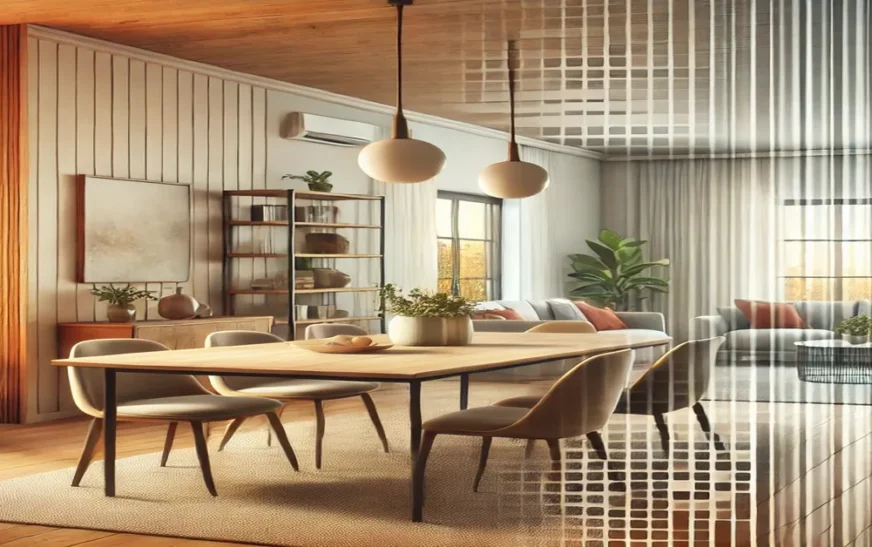In recent years, a notable trend has emerged in American home design: the gradual disappearing dining rooms. Once a staple of family life and social gatherings, the dining room is increasingly being omitted from new home designs or repurposed for other uses. This phenomenon has raised questions about the evolving nature of domestic spaces and what it says about changing lifestyles. In this article, we’ll explore the reasons behind the dining room’s decline, the cultural implications, and what this shift might mean for the future of home design.
The Historical Significance of the Dining Room
To understand why dining rooms are disappearing, it’s important to first appreciate their historical significance. The dining room has long been a symbol of family unity and social status. In Victorian times, for instance, the dining room was a place where families gathered for daily meals, and it often served as a stage for formal dinner parties. The room was typically furnished with a large table, ornate chairs, and sometimes a sideboard or china cabinet, reflecting the homeowner’s taste and wealth.
In American homes, the dining room continued to hold an important place throughout much of the 20th century. It was the heart of family gatherings, especially during holidays like Thanksgiving and Christmas. The room was not just a place to eat, but a space where important conversations were had, and memories were made. However, as we moved into the 21st century, the way people lived and used their homes began to change dramatically.
The Rise of Open-Concept Living
One of the primary factors contributing to the disappearing dining room is the rise of open-concept living. This design trend, which gained popularity in the late 20th and early 21st centuries, emphasizes large, open spaces that combine the kitchen, living, and dining areas into one continuous room. This approach appeals to modern homeowners for several reasons:
- Flexibility: Open-concept spaces are more flexible, allowing homeowners to use the space in various ways depending on their needs. The absence of walls creates a more versatile environment where the dining area can easily become a part of the living room or kitchen.
- Social Interaction: Open-concept designs foster better social interaction. Without walls separating the kitchen, dining, and living areas, family members and guests can easily converse and interact, making these spaces more inclusive and engaging.
- Natural Light: Removing walls allows more natural light to flow through the home, making the space feel brighter and more inviting. This is particularly appealing in smaller homes where natural light is at a premium.
- Aesthetic Appeal: The minimalist aesthetic of open-concept living is aligned with modern tastes. It eliminates clutter and creates a clean, streamlined look that many homeowners find appealing.
The Shift in Family Dynamics and Eating Habits
Another significant reason why dining rooms are disappearing from American homes is the shift in family dynamics and eating habits. Traditional family meals, where everyone sits down together at the same time, are becoming less common. Busy lifestyles, varied work schedules, and different dietary preferences mean that family members are often eating at different times and in different places.
- On-the-Go Eating: In today’s fast-paced world, many people are eating on the go or choosing quick, convenient meals that don’t require a formal dining setting. The rise of fast food, takeout, and ready-made meals has also contributed to this trend.
- Casual Dining: There’s been a move towards more casual dining experiences, even at home. People are more likely to eat in the kitchen, at a breakfast bar, or in front of the TV rather than in a formal dining room. The casualization of meals reflects broader cultural shifts towards informality in many aspects of life.
- Tech and Media Influence: The integration of technology and media into daily life has also played a role. With the rise of smartphones, tablets, and streaming services, people are more likely to eat while watching TV or browsing the internet. This has made the living room or even the bedroom a more common place for meals, further diminishing the need for a dedicated dining room.
The Role of Real Estate and Home Design Trends
Real estate trends and the economics of home design have also played a crucial role in the disappearance of the dining room. The cost of building and buying homes has risen significantly, leading homeowners to make more strategic choices about how they use space.
- Space Optimization: As home sizes have decreased, particularly in urban areas where space is at a premium, homeowners are opting to allocate limited square footage to more essential or functional rooms. Bedrooms, home offices, and expanded kitchen spaces often take priority over a formal dining room.
- Walk-In Closets and Storage: In many modern homes, space that might have once been used for a dining room is now being repurposed for larger walk-in closets, additional bathrooms, or more storage space. These are seen as more practical and valuable features, especially for resale purposes.
- Multi-Functional Spaces: The demand for multi-functional spaces has grown, leading to the dining room being absorbed into a larger, more versatile area. For example, what might have once been a dining room could now be a part of an open-concept kitchen that doubles as a workspace, homework area, or even a casual living space.
- Real Estate Marketing: Real estate marketing has also shifted its focus. Homes are increasingly advertised with “great rooms” or “family rooms” that incorporate dining areas rather than separate dining rooms. This shift reflects the changing priorities of homebuyers and the evolving function of domestic spaces.
The Cultural Implications of Disappearing Dining Rooms
The vanishing dining room is more than just a design trend; it reflects broader cultural changes in how we live, work, and socialize. The room that once symbolized family unity and tradition is disappearing, raising questions about the future of social interaction and the role of the home in our lives.
- Changing Social Norms: The decline of the dining room mirrors the shift away from traditional social norms. As society becomes more fast-paced and individualistic, the importance of formal family gatherings has diminished. The dining room, once a space for ritual and routine, no longer fits the lifestyles of many modern families.
- Impact on Family Dynamics: The disappearance of the dining room may have implications for family dynamics. The ritual of sitting down together for a meal has long been associated with stronger family bonds and better communication. As families move away from this tradition, there may be a corresponding decline in the quality of family interactions.
- The Rise of the Kitchen as the New Social Hub: While the dining room is disappearing, the kitchen is emerging as the new social hub of the home. In many modern homes, the kitchen is not just a place to cook but also a place to gather, work, and entertain. The open-concept kitchen/dining/living area has become the heart of the home, where families and friends come together in a more casual and relaxed setting.
- Nostalgia and Sentimentality: For some, the disappearance of the dining room evokes a sense of nostalgia and loss. The dining room is often associated with memories of family meals, holiday gatherings, and special occasions. As this space disappears, so too does a connection to these traditions.
The Atlantic and the Discussion on Disappearing Dining Rooms
The topic of disappearing dining rooms has been explored in various media outlets, including The Atlantic, which published an article titled “Why Dining Rooms Are Disappearing.” The article discusses how the decline of the dining room reflects broader changes in American life and culture. It points out that the dining room’s disappearance is not just about changing tastes in home design but also about the changing ways in which we interact with each other and use our homes.
The Atlantic article highlights several key points that are central to understanding why dining rooms are disappearing:
- The Shift Towards Informality: The article notes that the shift towards more informal living and dining arrangements reflects a broader cultural move away from formality in general. This is evident not only in home design but also in fashion, work, and social interactions.
- The Rise of Practicality: Practical considerations are also a driving force behind the disappearing dining room. The article argues that as families become busier and more dispersed, the need for a formal dining space has diminished. Instead, people are looking for more practical, multi-functional spaces that can adapt to their changing needs.
- The Influence of Technology: Technology plays a significant role in the changing dynamics of home life. The Atlantic article suggests that the ubiquity of screens and devices has transformed how we spend our time at home, making the formal dining room less relevant in an age where people are more likely to eat while engaging with technology.
- A Reflection of Broader Social Changes: Ultimately, the disappearance of the dining room is a reflection of broader social changes. The article suggests that as society becomes more fragmented and individualistic, the spaces that once brought people together, like the dining room, are becoming less necessary.
The Future of Dining Rooms in American Homes
As we look to the future, it’s clear that the traditional dining room may never regain its former prominence. However, this doesn’t necessarily mean that the concept of dining together is disappearing altogether. Instead, it’s evolving to fit the needs and lifestyles of modern families.
- Reimagining the Dining Room: While formal dining rooms may be disappearing, many homeowners are finding creative ways to incorporate dining spaces into their homes. This could involve combining the dining area with the kitchen or living room, creating a more integrated and flexible space that can be used for multiple purposes.
- The Rise of the Breakfast Nook: The breakfast nook, a small dining area often located in or near the kitchen, is becoming increasingly popular as an alternative to the formal dining room. These cozy spaces are perfect for casual meals and can serve as a multifunctional area for dining, homework, or even home office work.
- Dining as an Experience: For some, dining has become more about the experience than the space. Pop-up dining events, outdoor dining, and even virtual dining experiences are gaining popularity, offering new ways to connect with others over a meal. These trends reflect the changing nature of dining and the desire for more unique and personalized experiences.
- Sustainability and Minimalism: As sustainability and minimalism continue to influence home design, the trend towards smaller, more efficient living spaces is likely to continue. This could further reduce the need for large, formal dining rooms, as homeowners prioritize functionality and environmental impact over traditional design elements.
Conclusion: The Disappearing Dining Room as a Sign of the Times
The disappearance of the dining room is a sign of the changing times. As our lifestyles evolve, so too do the spaces we inhabit. The formal dining room, once a symbol of family togetherness and social status, is being replaced by more flexible, multi-functional spaces that better align with modern living.
While the disappearing dining rooms, the need for connection and social interaction remains. The way we dine and gather may be changing, but the importance of these rituals is as strong as ever. Whether in a cozy breakfast nook, around a kitchen island, or at a pop-up dinner event, the act of coming together over a meal continues to play a vital role in our lives.
As we move forward, it will be interesting to see how home design continues to evolve in response to these changes. The dining room may be vanishing from American homes, but its legacy lives on in the way we design, use, and think about the spaces where we live and connect with others.
Read: Revo Technologies Murray Utah: A Deep Dive into Innovation and Excellence






